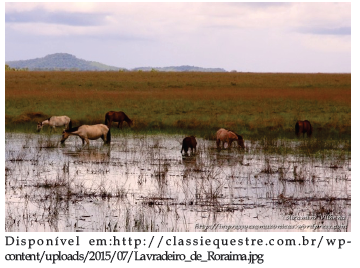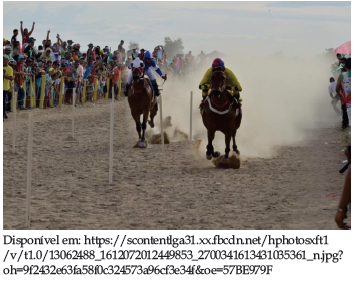Questões de Concurso
Foram encontradas 65.259 questões
Resolva questões gratuitamente!
Junte-se a mais de 4 milhões de concurseiros!
Esse texto refere‐se à definição de
I. não punitivo e confidencial; II. com capacidade de identificar o tipo de incidente e quem cometeu; III. independente e seus dados analisados por organizações; IV. baseado em dados georeferenciados; V. com respostas oportunas para os usuários e orientado para soluções dos problemas notificados.
Estão corretas as características indicadas em
Disponível em:http://www.folhabv.com.br/noticia/Indigenasestao-morrendo-contaminados-por-mercurio--denuncia-liderYanomami/15219>
Sobre a contaminação por mercúrio é correto afirmar que:
BRAZILIAN INDIANS
The history of Brazil's indigenous
peoples has been marked by brutality, slavery,
violence, diseases, and genocide.
When the first European colonists
arrived in 1500, what is now Brazil was
inhabited by an estimated 11 million Indians,
living in about 2,000 tribes. Within the rst
century of contact, 90% were wiped out, mainly
through diseases imported by the colonists,
such as fiu, measles and smallpox. In the
following centuries, thousands more died,
enslaved in the rubber and sugar cane
plantations.
By the 1950s the population has
dropped to such a low that the eminent senator
and anthropologist Darcy Ribeiro predicted
there would be none left by the year 1980. On
average, it is estimated that one tribe became
extinct every year over the last century.
In 1967, a federal prosecutor named
Jader Figueiredo published a 7,000 page report
cataloguing thousands of atrocities and crimes
committed against the Indians, ranging from
murder to land theft to enslavement.
In one notorious case known as 'The
th massacre of the 11 parallel', a rubber baron
ordered his men to hurl sticks of dynamite into
a Cinta Larga village. Those who survived were
murdered when rubber workers entered the
village on foot and attacked them with
machetes.
The report made int e rna tiona l headlines and led to the disbanding of the government's Indian Protection Service (SPI) which was replaced by FUNAI. This remains the government' s indigenous a ff a ir s department today.
The size of the indigenous population gradually started to grow once more, although when the Amazon was opened up for development by the military in the 1960s, 70s and 80s, a new wave of hydro-electric dams, cattle ranching, mines and roads meant tens of thousands of Indians lost their lands and lives. Dozens of tribes disappeared forever.
Twenty-two years of military dictatorship ended in 1985, and a new Constitution was drawn up. Indians and their supporters lobbied hard for more rights. Much has been achieved, although Indians do not yet enjoy the collective landownership rights they are entitled to under international law.
BRAZILIAN INDIANS
The history of Brazil's indigenous
peoples has been marked by brutality, slavery,
violence, diseases, and genocide.
When the first European colonists
arrived in 1500, what is now Brazil was
inhabited by an estimated 11 million Indians,
living in about 2,000 tribes. Within the rst
century of contact, 90% were wiped out, mainly
through diseases imported by the colonists,
such as fiu, measles and smallpox. In the
following centuries, thousands more died,
enslaved in the rubber and sugar cane
plantations.
By the 1950s the population has
dropped to such a low that the eminent senator
and anthropologist Darcy Ribeiro predicted
there would be none left by the year 1980. On
average, it is estimated that one tribe became
extinct every year over the last century.
In 1967, a federal prosecutor named
Jader Figueiredo published a 7,000 page report
cataloguing thousands of atrocities and crimes
committed against the Indians, ranging from
murder to land theft to enslavement.
In one notorious case known as 'The
th massacre of the 11 parallel', a rubber baron
ordered his men to hurl sticks of dynamite into
a Cinta Larga village. Those who survived were
murdered when rubber workers entered the
village on foot and attacked them with
machetes.
The report made int e rna tiona l headlines and led to the disbanding of the government's Indian Protection Service (SPI) which was replaced by FUNAI. This remains the government' s indigenous a ff a ir s department today.
The size of the indigenous population gradually started to grow once more, although when the Amazon was opened up for development by the military in the 1960s, 70s and 80s, a new wave of hydro-electric dams, cattle ranching, mines and roads meant tens of thousands of Indians lost their lands and lives. Dozens of tribes disappeared forever.
Twenty-two years of military dictatorship ended in 1985, and a new Constitution was drawn up. Indians and their supporters lobbied hard for more rights. Much has been achieved, although Indians do not yet enjoy the collective landownership rights they are entitled to under international law.
BRAZILIAN INDIANS
The history of Brazil's indigenous
peoples has been marked by brutality, slavery,
violence, diseases, and genocide.
When the first European colonists
arrived in 1500, what is now Brazil was
inhabited by an estimated 11 million Indians,
living in about 2,000 tribes. Within the rst
century of contact, 90% were wiped out, mainly
through diseases imported by the colonists,
such as fiu, measles and smallpox. In the
following centuries, thousands more died,
enslaved in the rubber and sugar cane
plantations.
By the 1950s the population has
dropped to such a low that the eminent senator
and anthropologist Darcy Ribeiro predicted
there would be none left by the year 1980. On
average, it is estimated that one tribe became
extinct every year over the last century.
In 1967, a federal prosecutor named
Jader Figueiredo published a 7,000 page report
cataloguing thousands of atrocities and crimes
committed against the Indians, ranging from
murder to land theft to enslavement.
In one notorious case known as 'The
th massacre of the 11 parallel', a rubber baron
ordered his men to hurl sticks of dynamite into
a Cinta Larga village. Those who survived were
murdered when rubber workers entered the
village on foot and attacked them with
machetes.
The report made int e rna tiona l headlines and led to the disbanding of the government's Indian Protection Service (SPI) which was replaced by FUNAI. This remains the government' s indigenous a ff a ir s department today.
The size of the indigenous population gradually started to grow once more, although when the Amazon was opened up for development by the military in the 1960s, 70s and 80s, a new wave of hydro-electric dams, cattle ranching, mines and roads meant tens of thousands of Indians lost their lands and lives. Dozens of tribes disappeared forever.
Twenty-two years of military dictatorship ended in 1985, and a new Constitution was drawn up. Indians and their supporters lobbied hard for more rights. Much has been achieved, although Indians do not yet enjoy the collective landownership rights they are entitled to under international law.

Com base na estrutura do limoneno é correto afirmar que:

Em 2015, a maior melancia atingiu 24 kg. Considerando a aceleração da gravidade no local 10 m/s² , é correto afirmar que a maior melancia no ano de 2015 atingiu um peso de:

A aceleração de um Cavalo Selvagem em 4 segundos é de:

O cavalo mais lento percorreu 300 metros em 20 segundos, atingindo uma velocidade média de:
( ) Nas áreas emersas, a crosta terrestre é formada por três tipos de estruturas geológicas, caracterizadas pelos tipos de rochas predominantes, seu processo de formação e sua idade geológica.
( ) As estruturas geológicas da Terra são os dobramentos modernos, os escudos cristalinos(maciços antigos) e as bacias sedimentares.
( ) Os dobramentos modernos são trechos da crosta terrestre de formação antiga e, por esta razão, compostos por rochas mais flexíveis e maleáveis.
( ) Os maciços antigos, também chamados de escudos cristalinos, são os terrenos mais recentes da crosta terrestre. Datam da era Pré-cambriana (Proterozóica) e são constituídos basicamente por rochas sedimentares.
( ) O Brasil apresenta duas estruturas geológicas maciços antigos e bacias sedimentares, não se vericando a existência de dobramentos modernos.
A sequência correta das assertivas que você assinalou acima é: